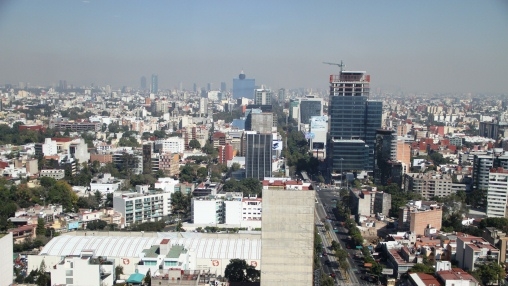In the first hours of 2013, many in Mexico City may have experienced itchy eyes and a dry throat. After the New Year’s celebrations, the air quality in the capital was notably worse.
The city’s environment ministry warned of a “precontingencia ambiental” for some parts of the urban area – a certain level of bad air quality. It recommended that children and older people stay inside, and that sport activities outside should be avoided. The warning was lifted the next day.
In other parts of the country, there are dozens of lively and cosmopolitan cities, but this comes with high levels of air pollution. 77% of Mexicans live in urban areas. The country’s 70 largest cities produce more than 84% of their country’s GDP, as well as an estimated three quarters of its greenhouse gas emissions.
This is why one of Mexico’s main challenges is to make urban development more environment-friendly, efficient and resilient to climate change, as well as including all social groups, a World Bank analysis shows.
Promote compact cities
One of the issues Mexico should focus on is a coordinated urban and land use planning, by harmonizing efforts among government agencies that deal with the issue, and designing comprehensive urban development policies and guidelines.
A new agency could integrate these tasks and teams that are currently scattered among several ministries and organizations, a World Bank analysis proposes.
One of the functions this agency could undertake is the promotion of more compact cities. When houses are built in such a manner that the city expands continuously, it creates a patchy urban pattern that makes it difficult and expensive to provide adequate services and transportation.
Public transportation cannot reach all the new urban constructions that are far away from the center, and a private car becomes almost indispensable.
Between 1996 and 2006, the number of vehicles in Mexico nearly tripled. The government of Mexico is conscious of this situation and has already launched a massive transport program that is starting to change how cities function.
Better solid waste management
In general, the estimated cost of environmental degradation in 2008 was 6.3% of the country’s GDP.
The generation of solid waste grows every year in Mexico. But while 87% of solid waste is collected, only 64% is actually disposed of in landfills or controlled sites.
Issues include the insufficient number of facilities to dispose of solid or hazardous waste, as well as serious air, water and land pollution. Mexico has already environmental legislation and protection strategies, but they are not always implemented in small municipalities.
This can be due to a lack of technical management capacities, or problems with the financing of the activities. An integrated waste management strategy at all government levels could tackle these issues, according to World Bank analysis.
Use energy more efficiently
Mexico is the second largest electricity producer in Latin America. This makes the sector a crucial one to reduce the footprint of Mexico’s growth: there are many opportunities to use energy efficiently.
More energy efficiency standards in buildings, transportation or small businesses, for example, could contribute to this goal.
Mexico has already won a Guinness world record because of the number of energy efficient light bulbs the government had managed to give out to citizens, in exchange of normal ones. It also has standards for different equipment used in the household.
The country is generally considered a leader in climate change mitigation and adaptation in the region. By continuing its efforts, it might be able to reach the goal it has set itself in its environment law – halving its emissions by 2050.
The World Bank stands ready to support the government of Mexico to take on these challenges, with a full package, including knowledge , convening and financial services, that are tailored to the needs and context of the country.

